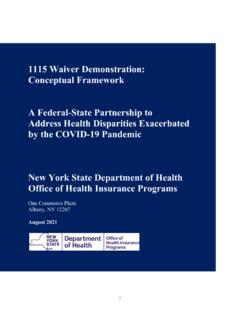Transcription of Impact of Hospital Readmissions Reduction Initiatives on ...
1 Impact of Hospital Readmissions Reduction Initiatives on Vulnerable Populations SEPTEMBER 2020 PRESENTED TO: Meagan Khau Jessica Maksut CMS Office of Minority Health Centers for medicare & medicaid services 7500 Security Boulevard Baltimore, MD 21244 PRESENTED BY: Carrie Mills Melanie Gaiser Robert Saunders Sarah Hudson Scholle National Committee for Quality Assurance (NCQA) 1100 13th Street NW, Third Floor Washington, 20005 Suggested citation: CMS Office of Minority Health. Impact of Hospital Readmissions Reduction Initiatives on Vulnerable Populations. Baltimore, MD: Centers for medicare & medicaid services ; September 2020. Paid for by the Department of Health and Human services . 2 TABLE OF CONTENTS TABLE OF CONTENTS ..2 EXECUTIVE SUMMARY.
2 3 INTRODUCTION ..6 METHODS ..7 Data Sources .. 7 Study Sample .. 8 Outcome Variable .. 8 Primary Exposures: Demographic and Clinical Factors .. 8 Stratification Variables .. 9 Additional Covariates .. 10 Statistical Analysis .. 10 RESULTS ..11 Admission and Readmission Rates by Demographic, Clinical, and Geographic Factors .. 11 Admission and Readmission Rates by Stratification Characteristics .. 12 Admission and Readmission Rates by Additional Covariates .. 13 Relationship Between Demographic, Clinical, and Geographic Factors and Readmission Rates Stratified by Key Characteristics .. 14 Hospital Quality .. 14 Diagnosis at Index Hospitalization .. 16 Discharge Setting .. 17 Geography .. 20 DISCUSSION ..21 Racial and Ethnic Disparities .. 21 Disability-Related Disparities in 22 Opportunities for Improvement.
3 23 LIMITATIONS ..24 REFERENCES ..26 APPENDIX A: COMPLETE FINDINGS ..29 APPENDIX B: 3 EXECUTIVE SUMMARY Issue Decreasing Hospital Readmissions defined as inpatient stays that occur within 30 days of discharge from an initial inpatient hospitalization is a high priority for the Centers for medicare & medicaid services (CMS). Hospital Readmissions are a known key quality of care indicator, and account for billions of dollars in annual medicare spending. In addition, populations made vulnerable through public policies, social inequity, and social bias are known to be at heightened risk for Hospital Readmissions , and this increased likelihood is known as a Readmissions disparity. Understanding the drivers of Readmissions disparities can help to improve health outcomes for medicare beneficiaries, particularly for those who are vulnerable, and in containing Readmissions -related costs.
4 Report Objective This study analyzed the roles that key demographic, clinical, and geographic characteristics, as well as Hospital quality and type factors, play in Hospital Readmissions among medicare beneficiaries, noting that beneficiaries of certain demographic, clinical, and geographic backgrounds may have higher risks by social risk factors, and the adverse health consequences associated with those factors, than by their counterparts of other backgrounds. Social risk factors include social and structural conditions that facilitate poor health outcomes. On average, individuals who are racial and/or ethnic minorities, individuals with disabilities, and individuals residing in rural and underserved communities may be disproportionately impacted by social risk factors and may as a result have unique health needs and concerns.
5 This study explored whether and to what extent Readmissions were associated with demographic and clinical characteristics, including race and ethnicity, potentially disabling condition status, dual eligibility status, as well as geographic characteristics of residence, including rurality. The overarching purpose of the analysis was to identify disparities in Readmissions across levels of the above indicators of interest ( race and ethnicity groups), stratified by (1) discharge settings ( home/self-care, skilled nursing facility, home health care, inpatient rehabilitation facility), (2) levels of Hospital quality, (3) a select set of high-frequency diagnoses, and (4) Census divisions. A more nuanced understanding of such associations supports the CMS Office of Minority Health s goal to achieve health equity across all medicare beneficiaries.
6 Key Findings Race and ethnicity, dual eligibility, and potentially disabling condition status were associated with medicare fee-for- services beneficiaries 30-day Readmissions . The readmission rate by race and ethnicity ranged from among non-Hispanic White beneficiaries to among non-Hispanic Black beneficiaries. Readmission rates were among Hispanic beneficiaries, among American Indian/Alaska Native beneficiaries, and among beneficiaries who were of Asian descent. Almost one-fifth ( ) of beneficiaries with dual eligibility had a readmission compared with of those without dual eligibility. Readmission rate differences were observed among beneficiaries with and without potentially disabling conditions such that the readmission rate among beneficiaries with potentially disabling conditions was compared with for beneficiaries without a potentially disabling condition.
7 Rate differences were also observed among beneficiaries with substance use disorder (SUD); of beneficiaries with SUD had a readmission compared to of those without SUD. The overall unadjusted 30-day Hospital readmission rate among all beneficiaries was 4 At the organization level, 30-day Readmissions differed across the quality of the treatment facility ( , the Hospital where initial admission occurred) as well as post-acute care setting at discharge. Beneficiaries whose index Hospital quality rating was 5 stars (highest rating) had the lowest readmission rate ( ) compared to beneficiaries whose index Hospital quality rating was 1 star ( ) (lowest rating). Discharges to inpatient psychiatric hospitals had the highest readmission rates ( ), followed by other post-acute care settings1 ( ), and critical access hospitals ( ), while the settings with the lowest Hospital readmission rates were hospice ( ), inpatient rehabilitation faci lity ( ), and home/self-care ( ).
8 We identified two groups that may benefit from targeted quality improvement (QI) interventions: Beneficiaries with potentially disabling conditions: Compared to beneficiaries without potentially disabling conditions, beneficiaries with potentially disabling conditions have: Higher odds of readmission across all levels of Hospital quality. Higher odds of readmission across a number of discharge settings, and particularly when discharged to home or self-care. Black/African American beneficiaries: Compared to non-Hispanic White beneficiaries, Black/African American beneficiaries have: Higher readmission rates across levels of Hospital quality. Greater likelihood of being treated at hospitals with lower quality ratings. Higher odds of being readmitted regardless of discharge setting (except for those discharged to long-term care hospitals).
9 Conclusion The study s results suggest that a framework designed to incentivize improved matching of discharge setting intensity with beneficiary needs may yield reductions in Readmissions and disparities in Readmissions across demographic and clinical characteristic groups. For example, individuals with potentially disabling conditions may experience unique barriers to adequately engage in follow-up care after discharge to home/self-care and may benefit from close follow-up monitoring to ensure that the resources necessary for their care are available to them at home. Some individuals with potentially disabling conditions may benefit from discharge to a higher-intensity setting; however, patients preferences should be considered. The results also suggest that targeted improvements to reduce disparities in 30 -day Hospital Readmissions may have potential for meaningful Impact if they are designed to drive health care organizations to focus on improving care for beneficiaries who are Black/African American, along with beneficiaries who have potentially disabling conditions, beneficiaries who are dually eligible for medicare and medicaid , and beneficiaries with substance use disorder (SUD).
10 Interventions may involve improvements in discharge planning and post-acute coordination of care for beneficiaries in these groups. Quality improvement Initiatives targeting lower-quality (1 3 stars) hospitals may reduce race and ethnicity disparities and improve readmission rates for 1 Other post-acute care settings included discharges to court/law enforcement, federal hospitals, and other types of health care institutions not specified elsewhere. 5 Black/African American beneficiaries, as index Hospital stays for Black/African American beneficiaries tend to occur in lower-quality facilities. 6 INTRODUCTION In 2013 alone, the cost of medicare Hospital Readmissions was $ billion (Strom et al., 2017). The Centers for medicare & medicaid services (CMS) has advanced multiple Initiatives to reduce the incidence of preventable Hospital Readmissions , in part, to reduce medicare spending.

















